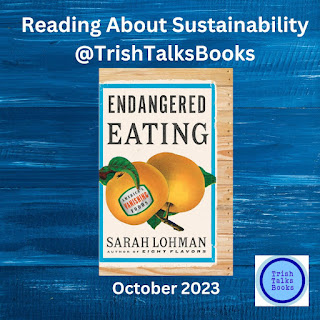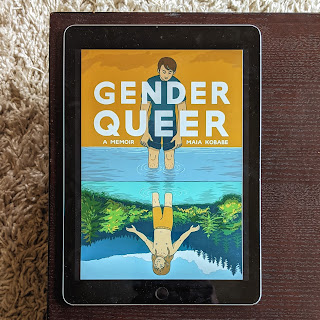Reading About Sustainability: Endangered Eating by Sarah Lohman
Reading About Sustainability @trishtalksbooks
October 2023
Thanks to Dreamscape Media and Netgalley for a digital ARC.
Read This Book If:
You’re a bit of a foodie or an avid gardener, and are in love with the natural culinary world. It’s a deep dive into some of the lost foods of North America, and the processes by which people have harvested and processed them. It’s like a love letter to slow foods and agricultural arcana, with a naturally occurring dose of sustainability education.
About the author:
I think “culinary historian” is about one of the coolest career-descriptors I can think of. Lohman’s bio notes that one of her first jobs as a 16-year-old was at a museum cooking historical foods over a wood-burning stove. She’s followed that culinary path and has a BFA from the Cleveland Institute of Art, then explored the food blogging world. She’s written one previous book: Eight Flavors: The Untold Story of American Cuisine (2016). She now works in the US, partnering with institutions creating public programs focused on food.
Why I wanted to read this:
For my Reading About Sustainability series, I’ve wanted to take a look at food and food systems. Unlike some of the books I’ve profiled, Endangered Eating is less focused on the typical modern sustainability issues, taking a different lens to the same concern. Taking a look back at where we’ve come from and what foods we’ve lost feels fundamental to informing the way we move forward.
Questions it answered:
For this book, Lohman spent a year travelling around the US following the seasonal patterns of several almost-lost foods and harvesting techniques. Her exploration has its roots in the organisation Slow Foods International, founded in 1989. One of its founding principles is to prevent the “disappearance of local food traditions and cultures.” A key initiative is the Ark of Taste, a catalogue of foods and food-processes that are endangered, with a goal to increase their production and improve biodiversity. A natural byproduct is the bolstering of small-scale production systems. As the book shows, this is often linked to Indigenous ways of eating and relating to food. Included foods must be Endangered, Good (prized for its taste or historical or cultural significance), Clean (not harmful to the environment) and Fair (no commercial or trademarked items included, and free to share or sell by all).
Lohman chose eight foods or processes to document: California’s Coachella valley dates; heirloom sugarcane in Hawaii; Navajo-Churro lamb in the Navajo Nation; the reefnet fishing technique for pink salmon in the Pacific Northwest; manoomin wild rice in the Midwest; rare cider apples in New York; Cajun cuisine’s filé powder in Louisiana; and the Carolina African Runner peanut in South Carolina.
What I loved about the book was that Lohman told us not only the current story of each food or technique, but also married it to the history of that region or cultural group: A crash-course in the modern revival of that food but also a history lesson. Personally, I think that knowing this history is integral to understanding its modern day importance in our culinary world. This brought up some tensions! Does it matter who champions an endangered food? Often it’s a settler culture rather than an Indigenous community that revives a technique. Kudos to Lohman: she shows different points of view and generally allows the reader to think deeply about it and come to their own conclusion. As with many things in life, there’s usually not a black and white answer.
A related question is that of commercial interests. Is something lost or endangered only as valuable as its economic value? Hmmm.
While every chapter kept me invested, I was taken with three in particular.
October 2023
Endangered Eating: America's Vanishing Foods by Sarah Lohman
W.W. Norton (2023)Thanks to Dreamscape Media and Netgalley for a digital ARC.
Read This Book If:
You’re a bit of a foodie or an avid gardener, and are in love with the natural culinary world. It’s a deep dive into some of the lost foods of North America, and the processes by which people have harvested and processed them. It’s like a love letter to slow foods and agricultural arcana, with a naturally occurring dose of sustainability education.
About the author:
I think “culinary historian” is about one of the coolest career-descriptors I can think of. Lohman’s bio notes that one of her first jobs as a 16-year-old was at a museum cooking historical foods over a wood-burning stove. She’s followed that culinary path and has a BFA from the Cleveland Institute of Art, then explored the food blogging world. She’s written one previous book: Eight Flavors: The Untold Story of American Cuisine (2016). She now works in the US, partnering with institutions creating public programs focused on food.
Why I wanted to read this:
For my Reading About Sustainability series, I’ve wanted to take a look at food and food systems. Unlike some of the books I’ve profiled, Endangered Eating is less focused on the typical modern sustainability issues, taking a different lens to the same concern. Taking a look back at where we’ve come from and what foods we’ve lost feels fundamental to informing the way we move forward.
Questions it answered:
For this book, Lohman spent a year travelling around the US following the seasonal patterns of several almost-lost foods and harvesting techniques. Her exploration has its roots in the organisation Slow Foods International, founded in 1989. One of its founding principles is to prevent the “disappearance of local food traditions and cultures.” A key initiative is the Ark of Taste, a catalogue of foods and food-processes that are endangered, with a goal to increase their production and improve biodiversity. A natural byproduct is the bolstering of small-scale production systems. As the book shows, this is often linked to Indigenous ways of eating and relating to food. Included foods must be Endangered, Good (prized for its taste or historical or cultural significance), Clean (not harmful to the environment) and Fair (no commercial or trademarked items included, and free to share or sell by all).
Lohman chose eight foods or processes to document: California’s Coachella valley dates; heirloom sugarcane in Hawaii; Navajo-Churro lamb in the Navajo Nation; the reefnet fishing technique for pink salmon in the Pacific Northwest; manoomin wild rice in the Midwest; rare cider apples in New York; Cajun cuisine’s filé powder in Louisiana; and the Carolina African Runner peanut in South Carolina.
What I loved about the book was that Lohman told us not only the current story of each food or technique, but also married it to the history of that region or cultural group: A crash-course in the modern revival of that food but also a history lesson. Personally, I think that knowing this history is integral to understanding its modern day importance in our culinary world. This brought up some tensions! Does it matter who champions an endangered food? Often it’s a settler culture rather than an Indigenous community that revives a technique. Kudos to Lohman: she shows different points of view and generally allows the reader to think deeply about it and come to their own conclusion. As with many things in life, there’s usually not a black and white answer.
A related question is that of commercial interests. Is something lost or endangered only as valuable as its economic value? Hmmm.
While every chapter kept me invested, I was taken with three in particular.
- The Navajo-Churro lamb: I found this fascinating, probably because I’m not a meat eater, and I have to expand my comfort level to hear about animal slaughter. That said, I have come to appreciate the more humane and thoughtful use of animals for food that some cultures take. Expressing gratitude for the animal’s sacrifice; the principle of taking only what you need and leaving the rest; and using the whole animal is sustainable to our land and our humanity.
- Reefnet fishing for pink salmon in the Pacific Northwest: This is local to me, and it involves Indigenous nations here in British Columbia. I eat fish and try to make choices for more sustainable types of salmon. Pink is often seen as less desirable but may be more sustainable. I love the idea of this less harmful salmon harvesting technique that minimises species loss via bycatch.
- Manoomin wild rice in the Midwest: I have a thing for wonderful grains, and hearing the stories of how the Anishinaabe folk “knock” the grains into canoes then gather and sell them during the wild rice season was so cool. The marsh plants are so tall and thick that harvesters can get lost out on the water if they’re not careful. It taught me too about wetlands, and how our modern world destroys them. Reclaiming the marsh and swampland is so necessary.
This was an inspiring book that made me ponder our food and how we harvest it in a more longitudinal way. We can glean wisdom moving forward as the climate changes by appreciating local foods, continuing with traditional methods and maintaining respect for the land and the animals that we share our planet with. Our traditional foods sustain our cultural and environmental souls!
Further resources:
I’m super excited to see that Slow Food Canada has its own Ark of Taste division. There’s some cool stuff in there! Maybe I can grow some of the veggies in my garden:
https://arkoftaste.slowfood.ca/
Here’s the Slow Food International website:
https://www.slowfood.com/
And Sarah Lohman’s website. She has a twice-monthly newsletter:
https://sarahlohman.com/
Further resources:
I’m super excited to see that Slow Food Canada has its own Ark of Taste division. There’s some cool stuff in there! Maybe I can grow some of the veggies in my garden:
https://arkoftaste.slowfood.ca/
Here’s the Slow Food International website:
https://www.slowfood.com/
And Sarah Lohman’s website. She has a twice-monthly newsletter:
https://sarahlohman.com/



Comments
Post a Comment